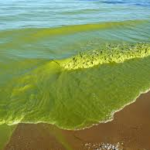Algae
Harmful Algal Blooms
Why is it an issue?
“Algae are vitally important to marine and fresh-water ecosystems, and most species of algae are not harmful. Algal blooms occur in natural waters used for drinking and/or recreation when certain types of microscopic algae grow quickly in water, often in response to changes in levels of chemicals such as nitrogen and phosphorus from fertilizer, in the water. Algal blooms can deplete the oxygen and block the sunlight that other organisms need to live, and some can produce toxins that are harmful to the health of the environment, plants, animals, and people.” (Read More from the CDC…)
“Algal blooms are not new to Lake Erie; they happened in the 60s and 70s too. Then the blooms were fueled by runoff from sewer overflows and poorly treated wastewater. The Clean Water Act helped provide funding and motivation to clean up the lake; while storm sewer overflows still happen, the tonnage of phosphorous flowing into Lake Erie was successfully reduced by nearly 60 percent in the last 40 years. But then algal blooms came back.
The problem is not as simple as “bad farmers”; farming best practices actually use fertilizer highly efficiently. Only about 2 percent of applied fertilizer is lost. The problem is volume; that many farms, golf courses, and suburban lawn owners applying fertilizer adds up, even if only a small amount washes off each allotment…
Municipal sewers are identifiable point sources of pollution; the problem now is thousands of individual farm and lawn owners. Mechanisms and laws for regulating point-source pollution, like sewer overflows, exist. A way to regulate the actions of millions of individual land owners… not so much. Urban sources represent about 20 percent of total basin Phosphorus input. Urban loading comes from storm water runoff, lawns and gardens, and pet waste.” (excerpted from Wired.com “Don’t Drink the Water… In Lake Erie”)
Storm water in our region flows into the Blanchard River which leads to the Auglaize River and eventually the Maumee River. The Maumee empties into the Western Basin of Lake Erie at Toledo, Ohio. Remember the Toledo water crisis in August of 2014? What we do here has an effect on a much bigger area than just our own back yard.
What can individuals do to help?
-
- Avoid using lawn fertilizers containing phosphorus
- Do not over apply any fertilizer and do not apply it when rain is expected in the next 24 hours
- When mowing your lawn, do not allow grass clippings to blow into the street where they will wash into the storm sewer
- If you have a home septic system, ensure that it is working properly
- Clean up and dispose of your pet’s waste
- Install a rain garden to catch runoff from your yard or business instead of letting it flow into storm sewers
- Instead of grass, leave a wide strip of deep rooted plants, such as wildflowers, trees and shrubs, along streams to prevent erosion.
- Farmers can use best management practices such as grass waterways and cover crops
Other Sites to Visit:
Ohio Dept of Health – Harmful Algal Blooms